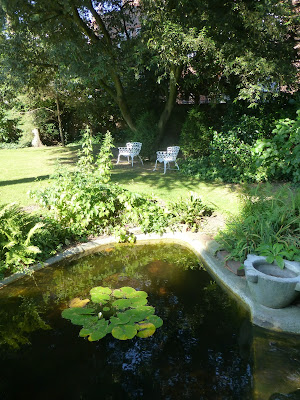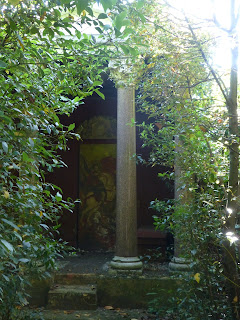And indeed like most of even North London, there wasn't very much around until the mid to late 19th century. Wimbledon Village was just that. Only really in the 1860s did commuting come into play, and rapidly the place filled up with big Victorian houses, and indeed banks.
Climbing up from Wimbledon station (which was built in the valley bottom and therefore below Wimbledon Village itself) one comes to the village church, St Mary's. Although an ancient church, it was rebuilt in the 19th century and so is quite a large, neat flint covered structure.
This big pyramid is pretty striking.
But its outshone by this one for the most famous "resident" of the graveyard, the civil engineer Sir Joseph Bazalgette, best known for building London's sewer system.
Wimbledon Village itself is pretty small, at least the pre 1860 part is.
Also along the Southside is a public school, King's College School, housed in a hotch-potch of buildings from this rather nice restrained house...
..to this grand piece of Victorian Gothic, unfortunately swathed in scaffolding. Behind one could hear the boys just back at school and in rugby practice, probably not enjoying the late summer heatwave as much as me. Getting on for 30 degrees is nice for a mid-afternoon stroll, but I suspect less so for scrum practice in rugger kit. Another week's holiday might have gone down well.

Alongside is this attractive green painted Gothic House dating from 1763.
But the real hidden gem in the area is this place, Southside House.
Now the term "hidden gem" is a bit of a cliché, and is bandied about quite liberally. For one thing, most aren't hidden, just not quite as well known as surrounding tourist spots. But I bet you have never heard of Southside House. If a house can hide its light under a bushel, this one certainly does. For a start it has pretty limited opening hours, and only by guided tours. One of those opening slots is a Wednesday afternoon, and hey presto I was here on a Wednesday afternoon. And it has no heating, so it is only open in summer.
It also qualifies for "gem" status because it contains, for its size, a phenomenal art collection. And a truly quirky set of contents in an amalgam of interior design styles, all in a Jacobean farmhouse with a Georgian wrapper. It was (and still is) the family seat in London of the Pennington-Mellor family. I won't go into the history of it - you really need to set aside an hour for the tour - but compared to most family histories, this one is really really fascinating, taking in a divorced bishop's daughter, a Swedish doctor and an eccentric war hero who became friends with Mick and Bianca Jagger. Colourful doesn't begin to describe it. Just note for example the lounging statue in the front garden - just look at the name - John Axel Viking Pennington Munthe (known as Peter!).
Now the other thing that strikes one so much about this place is that it is really not all big. Ok, its not exactly a workers cottage with a yard to the rear, but its by no means a grand house. It just pretends to be. The back garden is truly charming, again an over-used term. But in a small area they have created lots of different "rooms" and views. So for example, this "grotto" is a tiny water feature - not much bigger than a bird-bath.
There are several small lawns - just places you would love to settle down for an afternoon tea in.
The house itself contains an eclectic mix of heavy Jacobean furniture and an art collection graced by Van Dyck, Reynolds, Wilson, Raeburn, Kaufmann, Frith and Burne-Jones amongst others - the range reflecting the odd fortunes of the family.
Perhaps the oddest room is this dining room, lined with grand 17th century society portraits for which it is vastly too small, the collection having come from a much larger house. The room has slight Alice in Wonderland feel, just because it is so small for its contents.
The west side of the Common has its grand houses too - Chester House.
But most striking is Cannizaro House, which is now a hotel. It is a Queen Anne House, but the name comes from an "impoverished" 19th century resident, the Sicilian Duke of Cannizaro.
Regrettably, the rear of the house is defaced by a hideous extension. Hopefully the body of whichever planner approved this is still swinging from a tree somewhere.
But no, I have no idea what this is, at the top of a little alley-way on the way down to the station. You come across all sorts of things walking around in London!












































































































Thanks a lot for sharing us about this update. Hope you will not get tired on making posts as informative as this.
ReplyDeleteHouse Extension in Wimbledon